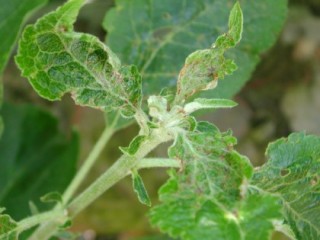
Common green capsid is a widespread and abundant readily recognised insect and, in some years, is an important pest of apple and pear.
The life cycle involves overwintering as eggs inserted by adults into the tender shoots of woody plants in the autumn. Rootstock sucker growths, especially at the edges of orchards where the pest is usually most abundant, often harbour the pest and should be removed in winter.
Apple and pear orchards should be inspected for the pest or signs of damage at the late blossom stage of apple. At least 25 trees per orchard should be examined for signs of damage.
Control
A spray of an approved insecticide should be applied promptly at petal fall if damaging infestations are detected.
- A full approval for spirotetramat (Batavia) on apples for the control of sucking insect pests will offer some control of common green capsid, but growers may prefer to reserve its use for more difficult to control pests such as woolly aphid or rosy apple aphid. It must be applied after flowering and works best when pests are moving from brown wood to green tissue. It will prevent population build-up but does not offer pest ‘knockdown’.
- Other novel insecticides recently approved for control of aphids on apple and/or pear in the UK may have useful activity against capsid bugs including acetamiprid (Gazelle) and flonicamid (Mainman).
Insecticides approved for use on apple that are recommended to control or are likely to offer incidental control of capsids, when applied to control other pests.
| Choice of insecticides - efficacy factors | |||||
|---|---|---|---|---|---|
| Active ingredient | Trade name (examples) | Class | Selectivity | Approved for control of | Safety to Typhs |
| acetamiprid | Gazelle | neonicotinoid | broad-spectrum systemic | Aphids | safe |
| deltamethrin | Decis Forte etc. | pyrethroid | broad spectrum | Aphids, apple sucker, capsids, codling & tortrix moths, sawfly | harmful |
| flonicamid | Mainman | chlordotonal organ modulator | selective | Aphids | safe |
| spirotetramat | Batavia | tetramic acid derivative | selective | Sucking insect pests | unclassified |
| Choice of insecticides – Safety factors Read and fllow label before applying any sprays |
|||||||
|---|---|---|---|---|---|---|---|
| Hazards | Harvest interval (days) | Max. no. sprays | Buffer zone width (m) | ||||
| Anticholin-esterase? | Humans | Fish & aquatic life | Bees | ||||
| acetamiprid | no | u | t | u | 14 | 2 | 20 |
| deltamethrin | no | h, i | ed | d | 7 | u | 50 |
| flonicamid | no | u | h | u | 21 | 3 | sm |
| spirotetramat | no | h, i | t | d | Start of ripening | 2 | 10 |
| h=harmful, i=irritant, d=dangerous, ed=extremely dangerous, t=toxic, c=closed cab required for air assisted sprayers, u=uncategorised/unclassified/unspecified | |||||||
Control in organic orchards
Greater emphasis should be placed on cultural and biological control methods in organic orchards.
- Pyrethrins (Pyrethrum 5 EC) was until 2020 approved for use in organic orchards but permission had to be sought from certification bodies before use.
- It was of short persistence and probably of limited activity.
- Pyrethrins was harmful to the orchard predatory mite Typhlodromus pyri, so use in organic orchards was to be avoided if possible.
- Neem extract does have an effect and is used in other European countries for control in organic orchards.
